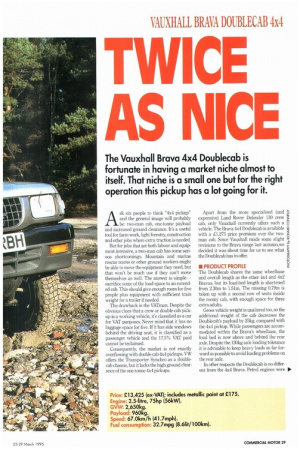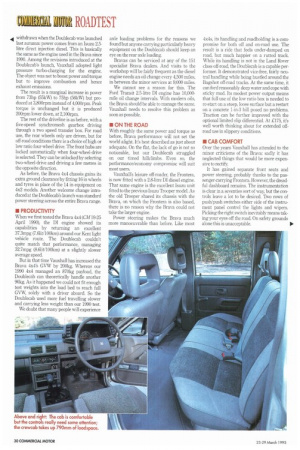TWICE AS RUC
Page 41

Page 42

If you've noticed an error in this article please click here to report it so we can fix it.
Ask six people to think "4x4 pickup" and the general image will probably be: two-man cab, one-tonne payload and increased ground clearance. It's a useful tool for farm work, light forestry, construction and other jobs where extra fraction is needed.
But for jobs that are both labour and equipment intensive, a two-man cab has some serious shortcomings. Mountain and marine rescue teams or other ground workers might be able to move the equipment they need, but that won't be much use if they can't move themselves as well The answer is simple— sacrifice some of the load space to an extended cab. This should give enough room for five people plus equipment with sufficient train weight for a trailer if needed.
The drawback is the VATinan. Despite the obvious clues that a crew or double-cab pickup is a working vehicle, it's classified as a car for VAT purposes. Never mind that it has no luggage space for five. If it has side windows behind the driving seat, it is classified as a passenger vehicle and the 17.5% VAT paid cannot be reclaimed.
Consequently, the market is not exactly overflowing with double cab 4x4 pickups. VW offers the Transporter Synchro as a doublecab chassis, but it lacks the high ground clearance of the one-tonne 4x4 pickups. Apart from the more specialised (and expensive) Land Rover Defender 130 crew cab, only Vauxhall currently offers such a 8 vehicle. The Brava 4x4 Doublecab is available with a £1,275 price premium over the two8 man cab. Since Vauxhall made some slight t revisions to the Brava range last autumn,we decided it was about time for us to see what the Doublecab has to offer.
The Doublecab shares the same wheelbase and overall length as the other 4x4 and 4x2 Bravas, but its load-bed length is shortened from 2.30m to 1.51m. The missing 0.79m is taken up with a second row of seats inside the roomy cab, with enough space for three extra adults.
Gross vehicle weight is unaltered too, so the additional weight of the cab decreases the Doublecab's payload by 25kg, compared with the 4x4 pickup. While passengers are accommodated within the Brava's wheelbase, the load bed is now above and behind the rear axle. Despite the 130kg axle loading tolerance it is advisable to keep heavy loads as far forward as possible to avoid loading problems on the rear axle.
In other respects the Doublecab is no different from the 4x4 Brava. Petrol engines were withdrawn when the Doublecab was launched last autumn: power comes from an Isuzu 2.5litre direct injection diesel. This is basically the same as the engine used in the Brava since 1990. Among the revisions introduced at the Doublecab's launch, Vauxhall adopted light pressure turbo-charging for the engine. The object was not to boost power and torque but to improve combustion and hence exhaust emissions.
The result is a marginal increase in power from 73hp (55kW) to 75hp (56kW) but produced at 3,800rpm instead of 4,000rpm. Peak torque is unchanged but it is produced 200rpm lower down, at 2,100rpm.
The rest of the driveline is as before, with a five-speed synchromesh gearbox driving through a two speed transfer box. For road use, the rear wheels only are driven, but for off-road conditions there is a choice of high or low ratio four-wheel drive. The front hubs are locked automatically when four-wheel-drive is selected. They can be unlocked by selecting two-wheel-drive and driving a few metres in the opposite direction.
As before, the Brava 4x4 chassis gains its extra ground clearance by fitting 16 in wheels and tyres in place of the 14 in equipment on 4x2 models. Another welcome change introduced at the Doublecab's launch was standard power steering across the entire Brava range.
When we first tested the Brava 4x4 (CM19-25 April 1990), the DI engine showed its capabilities by returning an excellent 37.3mpg (7.61it/100km) around our Kent light vehicle route. The Doublecab couldn't quite match that performance, managing 32.7mpg (8.61it/100km) at a slightly slower average speed.
But in that time Vauxhall has increased the Brava 4x4's GVW by 200kg. Whereas our 1990 4x4 managed an 870kg payload, the Doublecab can theoretically handle another 90kg. As it happened we could not fit enough test weights into the load bed to reach full GVW, solely with a driver aboard. So the Doublecab used more fuel travelling slower and carrying less weight than our 1990 test.
We doubt that many people will experience axle loading problems for the reasons we found but anyone carrying particularly heavy equipment on the Doublecab should keep an eye on the rear axle loading.
Bravas can be serviced at any of the 151 specialist Brava dealers. And visits to the workshop will be fairly frequent as the diesel engine needs an oil change every 4,500 miles, in between the minor services at 9,000 miles.
We cannot see a reason for this. The Ford Transit 2.5-litre DI engine has 10,000mile oil change intervals. With modern oils, the Brava should be able to manage the same. Vauxhall needs to resolve this problem as soon as possible.
With roughly the same power and torque as before, Brava performance will not set the world alight. It's best described as just about adequate. On the fiat, the lack of go is not so noticeable, but our Doublecab struggled on our timed hillclimbs. Even so, the performance/economy compromise will suit most users.
Vauxhall's leisure off-roader, the Frontera, is now fitted with a 2.8-litre DI diesel engine. That same engine is the excellent Isuzu unit fitted to the previous Isuzu Trooper model. As the old Trooper shared its chassis with the Brava, on which the Frontera is also based, there is no reason why the Brava could not take the larger engine.
Power steering makes the Brava much more manoeuvrable than before. Like most 4x4s, its handling and roadholding is a compromise for both off and on-road use. The result is a ride that feels under-damped on road, but much happier on a rutted track. While its handling is not in the Land Rover class off-road, the Doublecab is a capable performer. It demonstrated vice-free, fairly neutral handling while being hustled around the Bagshot off-road tracks. At the same time, it can ford reasonably deep water and cope with sticky mud. Its modest power output means that full use of the low ratio box is needed to re-start on a steep, loose surface but a restart on a concrete 1-in-3 hill posed no problems. Traction can be further improved with the optional limited slip differential. At £175, it's well worth thinking about for extended offroad use in slippery conditions.
Over the years Vauxhall has attended to the minor criticisms of the Brava: sadly it has neglected things that would be more expensive to rectify.
It has gained separate front seats and power steering, probably thanks to the passenger-carrying Frontera. However, the dreadful dashboard remains. The instrumentation is clear in a seventies sort of way, but the controls leave a lot to be desired. Two rows of push/push switches either side of the instrument panel control the lights and wipers. Picking the right switch inevitably means taking your eyes off the road. On safety grounds
alone this is unacceptable. 1110




































































































